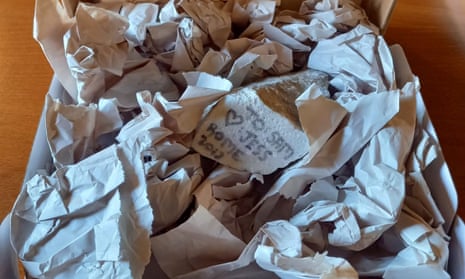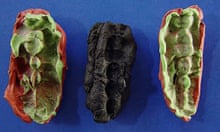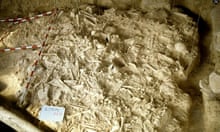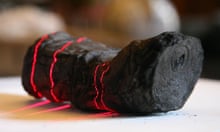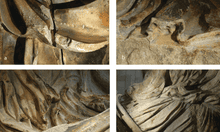Some of the repentant sinners may be compelled by guilt, others by superstition.
But Italian museum curators and archeological officers have observed a trend of tourists who, having pilfered artefacts from cultural sites, return them, years later, with a heartfelt letter of confession.
One American man, Bob Martin, went a step further in 2018 when he travelled all the way to Paestum, a vast archaeological park of ancient Greek ruins in the southern Italian region of Campania, to give back a small figurine he took from the site when he was a child.
“I was really surprised,” said Gabriel Zuchtriegel, the park’s director. “It wasn’t the first time this had happened but what was special is that the person wanted to come all this way. He sent me a photo [of the stolen item] before coming.”

Martin is now in his 60s, and it had been over 50 years since his misdeed. Similarly, with items returned to Pompeii or sites in Rome, or even precious sand taken from Sardinia, many of the thefts date back decades.
In his eight-year-old mind, Martin imagined the figurine, which was of prime quality and had probably been a feature of a rich person’s home in the city founded by the Greeks, were the bones of a Roman soldier.
“It was only at home that his desperate mother discovered it was actually a small piece of artwork,” added Zuchtriegel.
“So he had carried this around with him for almost a lifetime and that’s actually the point – it becomes a burden. It’s almost irrational and often superstitious – they think that since they took this everything has gone wrong – and the only way to undo it is by giving it back.”
Superstition certainly played on the mind of Nicole, a Canadian woman who returned fragments she stole from the ancient city of Pompeii, claiming they were “cursed”.
In her letter of confession, received by park officials in October, Nicole blamed the theft, in 2005, for a run of misfortune that had befallen her since, including having breast cancer twice and experiencing financial hardship.
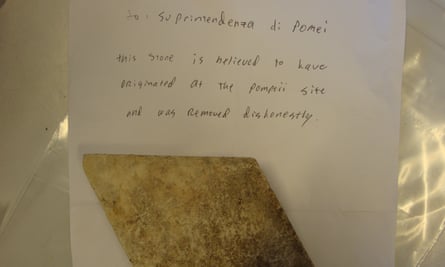
Over the years, so many stolen relics have been returned to Pompeii, along with letters expressing guilt, that a museum displaying the artefacts was established.
A letter written in English in 2015 and signed off only with C, said: “I would like to return this stone to the archaeological site. My boyfriend took it during our holiday in August and I feel rather wrong about it.” Another letter, in Italian, said. “I took this item in August 1975 … an error of youth.”
A few weeks after Nicole’s story made headlines, an American woman sent a package to the National Roman Museum containing a fragment of ancient marble inscribed with the message: “To Sam, love Jess, Rome 2017.”
In her confessional letter, she wrote: “Please forgive me for being such an American asshole and taking something that was not mine to take. I feel terribly for not only taking something from its rightful place, but placing writing on it as well.”
The museum’s management believe the artefact, thought to have come from the Roman Forum, which was the political heart of the Roman empire, was intended as a gift to her boyfriend.
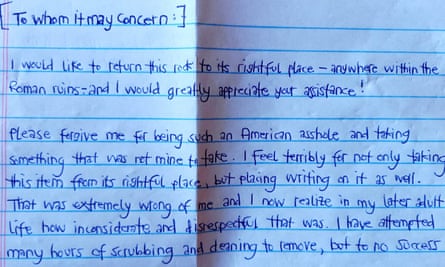
“This kind of theft can cause considerable damage,” said Dr Agnese Pergola, an archaeological officer at the museum. “Not only due to the removal of the artefact, which is a crime, but precisely because a piece of history that cannot be reconstructed is lost.”
A museum in Caprera, an island among the La Maddalena archipelago off Sardinia, also collates sand stolen from Budelli, an island famous for its pink-sanded beach.
Visitors have been barred from the beach since the mid-1990s, and so the confessional letters relate to sand thefts before then. An Italian tourist called Alessandro, overcome with guilt after visiting the museum in 2019, returned sand stolen from the pink beach in 1989.
“Unfortunately, they do not understand the value,” said Tomasso Gamboni, a manager at Caprera’s mineralogical and wildlife museum.
“Every year we have this problem, not just the archipelago but the rest of Sardinia – they take shells, stones and sand as a souvenir. Why can’t they just take a photo?”
